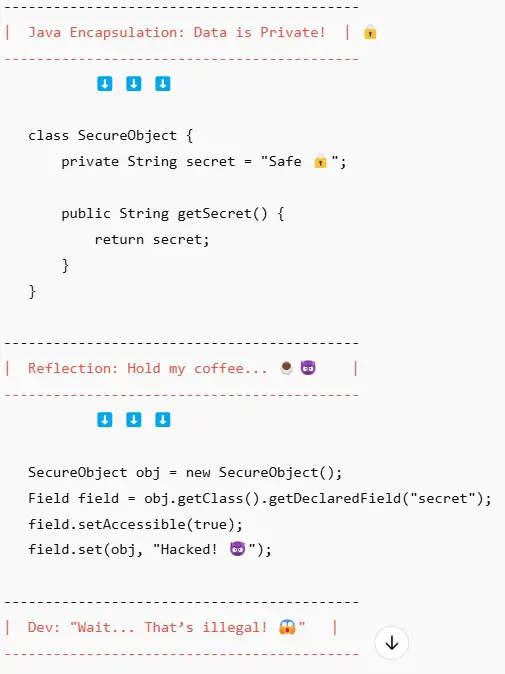How Spring Framework Breaks Java Encapsulation

Understanding Encapsulation in Spring Framework
Introduction to Encapsulation
Encapsulation is one of the four fundamental Object-Oriented Programming (OOP) principles. It restricts direct access to some of an object's components and can prevent the accidental modification of data. In Java, encapsulation is achieved using access modifiers (private, protected, public) to control access to class members. This principle not only helps in protecting the internal state of an object but also promotes modularity and maintainability in code.
By encapsulating data, developers can change the internal implementation of a class without affecting the classes that use it. This is crucial in large applications where different teams may work on different components.
How Spring Framework Interacts with Encapsulation
Spring Framework, while promoting good design practices, can sometimes break encapsulation principles. This occurs primarily through dependency injection and the use of reflection. Let's explore how these mechanisms work and their implications.

Dependency Injection
Dependency Injection (DI) is a core feature of the Spring Framework. It allows the creation of loosely coupled applications by injecting dependencies into classes rather than having them create their own dependencies. While DI promotes flexibility and testability, it can also lead to breaking encapsulation.
In a typical DI scenario, the Spring container manages the lifecycle of beans and their dependencies. This means that the internal state of a class can be influenced by external configurations, which may lead to unexpected behavior if not managed carefully.
Example of Dependency Injection
import org.springframework.beans.factory.annotation.Autowired;
import org.springframework.stereotype.Component;
@Component
public class UserService {
private UserRepository userRepository;
@Autowired
public UserService(UserRepository userRepository) {
this.userRepository = userRepository;
}
public void createUser(User user) {
userRepository.save(user);
}
}In the example above, the UserService class depends on UserRepository. The dependency is injected via the constructor, which is a common practice in Spring. However, this can lead to a situation where the internal state of UserService is modified by external components, potentially breaking encapsulation.
Reflection in Spring
Spring uses reflection extensively to manage beans and their dependencies. Reflection allows Spring to access private fields and methods, which can lead to unintended consequences regarding encapsulation. While reflection is a powerful feature, it can also introduce risks such as breaking encapsulation and making code harder to understand and maintain.
Using reflection can also lead to performance overhead, as it bypasses compile-time checks and can result in runtime errors that are harder to debug.
Example of Reflection
import java.lang.reflect.Field;
public class ReflectionExample {
private String secret = "Hidden Message";
public static void main(String[] args) throws Exception {
ReflectionExample example = new ReflectionExample();
Field field = ReflectionExample.class.getDeclaredField("secret");
field.setAccessible(true); // Bypassing encapsulation
String value = (String) field.get(example);
System.out.println(value); // Output: Hidden Message
}
}In this example, we use reflection to access a private field secret in the ReflectionExample class. By calling setAccessible(true), we bypass the encapsulation provided by the private modifier. This is a powerful feature but can lead to code that is difficult to maintain and understand.
Best Practices to Maintain Encapsulation in Spring
While Spring provides powerful features that can break encapsulation, there are best practices you can follow to mitigate these issues:
- Use Interfaces: Program to interfaces rather than concrete classes. This reduces coupling and maintains encapsulation.
- Limit Reflection Usage: Avoid using reflection unless absolutely necessary. If you must use it, document the reasons clearly.
- Encapsulate Dependencies: Keep dependencies private and expose only necessary methods to interact with them.
- Use Annotations Wisely: Be cautious with annotations like
@Autowiredand@Valuethat can expose internal state. - Implement Access Control: Use access modifiers effectively to restrict access to sensitive data and methods, ensuring that only authorized classes can interact with them.
- Document Your Code: Provide clear documentation for your classes and methods, especially when using DI and reflection, to help other developers understand the design decisions.
Conclusion
While the Spring Framework offers many advantages for building robust applications, it can inadvertently break Java's encapsulation principles through dependency injection and reflection. By understanding these interactions and following best practices, developers can maintain encapsulation and create more maintainable and understandable code.